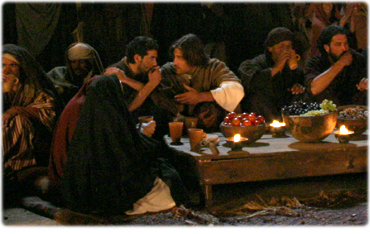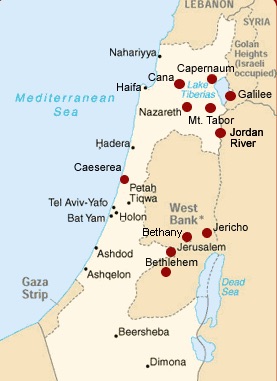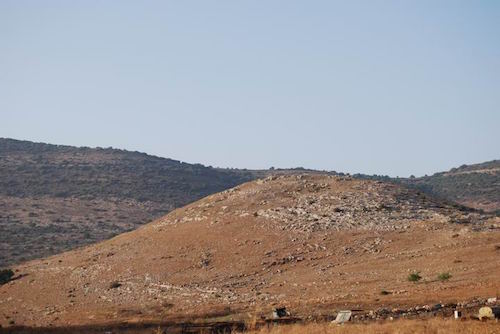A version of this article originally appeared on Dr. James Tabor’s popular Taborblog, a site that discusses and reports on “‘All things biblical’ from the Hebrew Bible to Early Christianity in the Roman World and Beyond.” Bible History Daily republished this article with permission from the author.
 There is a very intriguing story, unique to the Gospel of John, about a wedding attended by Jesus and his disciples at the Galilean village of Cana (John 2:1–11). Within the Gospel of John the story functions in a theological and even allegorical manner—it is the “first” of seven signs, the “water into wine” story, but that is not to say it lacks any historical foundation.
There is a very intriguing story, unique to the Gospel of John, about a wedding attended by Jesus and his disciples at the Galilean village of Cana (John 2:1–11). Within the Gospel of John the story functions in a theological and even allegorical manner—it is the “first” of seven signs, the “water into wine” story, but that is not to say it lacks any historical foundation.
The story is part of an earlier written narrative that scholars call the “Signs Source,” now embedded in the Gospel of John much like the Q source is embedded in Matthew and Luke. Many scholars consider the Signs Source to be our most primitive gospel narrative, earlier than, and independent from, the Gospel of Mark. Most readers of John’s gospel concentrate on the long “red letter” speeches and dialogues of Jesus with the lofty language about him as the “Son” sent from heaven, in cosmic struggle with “the Jews” who are cast in a pejorative light. Such elements are apparently a much later theological overlay, as they are absent from this primitive narrative source. The work, at least according to this “Signs Source,” was originally written to promote the simple affirmation that Jesus was the Messiah, the anointed King of the line of David, and to explain how his death was part of the plan of God. This narrative source is written in a completely different style from the later material now in John’s gospel. It moves along from scene to scene with vivid details and in gripping narrative flow.

The elements of the Cana story are fascinating. Jesus and his disciples, who have been down in the Jordan valley with John the Baptist, return to the area to join the wedding celebration. Jesus’ mother Mary (though unnamed in John) and his brothers are already there (2:12), so it seems to be some kind of “family affair.” Indeed, Mary seems to be at some level officially involved in the celebration as a kind of co-hostess since she takes charge of things when the wine planned for the occasion, unexpectedly runs out, indicating either that the crowd was larger than expected or that things became quite festive, or both. Mary turns to Jesus and the rest of the story is well known to everyone—he miraculously turns six stone vessels, filled initially with water, into the finest wine. But beyond the “miracle” or the “sign,” a number of other quite interesting questions arise.
First, one has to ask: Why would the lack of wine be a concern of Mary, Jesus’ mother? And what do we know about Cana? And most importantly, whose wedding was this and why were Jesus and his family present in the first place?

Let’s begin with Cana itself. What do we know about it? Most tourists are taken to the traditional site of Cana (Kefr Kenna) near Nazareth on the road to Tiberias that the Franciscans maintain. The problem is that this location has no Roman-period ruins and most certainly is not the place mentioned in the New Testament. Its veneration began sometime in the Middle Ages. An alternative site, Khirbet Qana, is 8 miles northwest of Nazareth and 12 miles west of the Sea of Galilee. It is high on a hill overlooking the Bet Netofa valley. This location has much more evidence in its favor. My colleague and friend, the late Professor Doug Edwards, began excavating there in 1998, and Tom McCollough has carried on his work as time has allowed. What they have found seems fairly decisive, including Second Temple period tombs, houses and possibly a beth midrash or synagogue. Evidence of Christian veneration at this site dates back to the sixth century C.E.
Right after the wedding, according to John 2:12, Jesus goes to Capernaum and with him are his disciples, but also his mother and his brothers. I think that implies the whole family, including the brothers (and thus the sisters) were not only at the wedding but are now traveling with him. They go to Capernaum, where he sets up a kind “residence” or operational HQ, according to the tradition that Mark has received (see Mark 2:1; 3:19; 9:33 and the references to the house and being “at home”). Mark knows nothing of Cana but John mentions it again when Jesus returns from a trip to Judea, where he stirred up a considerable amount of trouble and needs some place to “lay low.” He and his disciples go back to Cana (John 4:46). Why go back there if the first visit was just for a wedding and had no connection to him? I think this is important in that it seems to become for Jesus a kind of “safe house” or place of operations when he needs to retreat to Galilee, much like Capernaum.
Become a Member of Biblical Archaeology Society Now and Get More Than Half Off the Regular Price of the All-Access Pass!
Explore the world’s most intriguing Biblical scholarship
Dig into more than 9,000 articles in the Biblical Archaeology Society’s vast library plus much more with an All-Access pass.

There is definitely a “Jesus connection” to Cana, parallel to the one that Mark reports regarding Capernaum. Peter Richardson of the University of Toronto has written a significant academic article on this point titled “What Has Cana to Do with Capernaum?” (New Testament Studies 48 (2002), pp. 314–331) that I highly recommend. He argues that the significant differences on geographical matters between the Synoptics with their sources and John with its sources—especially the question of Jesus’ “place”—should not be resolved simply in favor of Mark. Cana as a place in John is as significant as Capernaum in Mark. In fact, Richardson argues that Cana served as an operational base for Jesus according to the tradition that John reflects. It is interesting to note that during the Jewish Revolt, Josephus, commander of the Jewish forces in Galilee, made Cana his strategic headquarters for a time (Life 86). Its prime location, overlooking Sepphoris and the cities of the Bet Netofa Valley, made it an ideal location. Also, Jewish tradition locates the priestly family of Eliashib, mentioned in 1 Chronicles 24:19 as one of the 24 orders of Cohanim or priest, as from Cana.

John indicates the connection in the last chapter of his gospel, where he says that the disciple Nathanael, mentioned only in the Gospel of John is from Cana in Galilee (21:2). Nathanael is mentioned earlier in the Gospel of John as an early follower or disciple, associated with Andrew of Bethsaida (1:45). He is most often identified as one of the Twelve, under his father’s name, Bar-Tholomew or “Bar Tolmai” in Aramaic, in Mark’s list of the disciples (Mark 3:18). I find this identification likely.
Given this background all we can do is speculate. I think we can assume that Mary, the mother of Jesus, is somehow involved in the wedding, and since we know Jesus and his disciples—as well as his brothers—are there, it is not a passing event but some kind of family affair. And since he returns to the place when things get heated for him and his disciples in Judea, it is a safe place for him, and one to which he is connected. So whose was the wedding? Or can we even make a wild guess?
Many have suggested that the wedding at Cana was that of Jesus. I find this unlikely. Even though the account is very “allegorical” as it comes to us in John, and it is accordingly hard to derive historical material therefrom, the way in which Jesus shows up with his disciples, when his mother and brothers are already there, indicates to me that the wedding is of someone else. My own guess would be that it is the wedding of either one of his brothers or sisters, since Mary is involved—not, as I read it, as the hostess, but as one concerned with the provisions for the wedding. Since the wedding is held in Cana, my guess is that it could very well be the wedding of one of Jesus’ brothers, perhaps James, to a sister or daughter of Nathanael, thus accounting for it being held in that village. Cana then becomes a place to which Jesus can return, and as with Capernaum, it served as a kind of “home” for him. Regardless, I do think, as Richardson has argued, that we should take John’s references to geographical locations as rooted in some of the earliest traditions we have related to the life of Jesus–even predating Mark.
I have of late become persuaded that Jesus well might have been married, and this represents a change of mind for me that I have detailed in our book The Jesus Discovery. If such be the case, it seems impossible to tell whether he would have been married long before this point in his life, perhaps in his 20s, or whether he chose not to be married into his adult life, and only subsequently did so closer to the end.

 Dr. James Tabor is Professor of Christian Origins and Ancient Judaism in the Department of Religious Studies at the University of North Carolina at Charlotte. Since earning his Ph.D. at the University of Chicago in 1981, Tabor has combined his work on ancient texts with extensive field work in archaeology in Israel and Jordan, including work at Qumran, Sepphoris, Masada, Wadi el-Yabis in Jordan. Over the past decade he has teamed up with with Shimon Gibson to excavate the “John the Baptist” cave at Suba, the “Tomb of the Shroud” discovered in 2000, Mt Zion and, along with Rami Arav, he has been involved in the re-exploration of two tombs in East Talpiot including the controversial “Jesus tomb.” Tabor is the author of the popular Taborblog, and several of his recent posts have been featured in Bible History Daily as well as the Huffington Post. His latest book, Paul and Jesus: How the Apostle Transformed Christianity, has become a immediately popular with specialists and non-specialists alike. You can find links to all of Dr. Tabor’s web pages, books, and projects at jamestabor.com.
Dr. James Tabor is Professor of Christian Origins and Ancient Judaism in the Department of Religious Studies at the University of North Carolina at Charlotte. Since earning his Ph.D. at the University of Chicago in 1981, Tabor has combined his work on ancient texts with extensive field work in archaeology in Israel and Jordan, including work at Qumran, Sepphoris, Masada, Wadi el-Yabis in Jordan. Over the past decade he has teamed up with with Shimon Gibson to excavate the “John the Baptist” cave at Suba, the “Tomb of the Shroud” discovered in 2000, Mt Zion and, along with Rami Arav, he has been involved in the re-exploration of two tombs in East Talpiot including the controversial “Jesus tomb.” Tabor is the author of the popular Taborblog, and several of his recent posts have been featured in Bible History Daily as well as the Huffington Post. His latest book, Paul and Jesus: How the Apostle Transformed Christianity, has become a immediately popular with specialists and non-specialists alike. You can find links to all of Dr. Tabor’s web pages, books, and projects at jamestabor.com.
Related reading in Bible History Daily:
Where Did Jesus Turn Water into Wine?
Was Mary Magdalene Wife of Jesus? Was Mary Magdalene a Prostitute?
Is the Gospel of Jesus’ Wife a Fake?
The Bethesda Pool, Site of One of Jesus’ Miracles
The Siloam Pool: Where Jesus Healed the Blind Man
This Bible History Daily article was first republished from James Tabor’s blog on November 16, 2015.
Dig deeper into biblical Archaeology with your All-Access Membership
The world of the Bible is knowable. We can learn about the society where the ancient Israelites, and later Jesus and the Apostles, lived through the modern discoveries that provide us clues.
Biblical Archaeology Review is the guide on that fascinating journey. Here is your ticket to join us as we discover more and more about the biblical world and its people.
Each issue of Biblical Archaeology Review features lavishly illustrated and easy-to-understand articles such as:
• Fascinating finds from the Hebrew Bible and New Testament periods
• The latest scholarship by the world's greatest archaeologists and distinguished scholars
• Stunning color photographs, informative maps, and diagrams
• BAR's unique departments such as First Person and Strata
• Reviews of the latest books on biblical archaeology
The BAS Digital Library includes:
• 45+ years of Biblical Archaeology Review
• 20+ years of Bible Review online, providing critical interpretations of biblical texts
• 8 years of Archaeology Odyssey online, exploring the ancient roots of the Western world in a scholarly and entertaining way,
• The New Encyclopedia of Archaeological Excavations in the Holy Land
• Video lectures from world-renowned experts.
• Full online access to 50+ curated Special Collections,
• Four highly acclaimed books, published in conjunction with the Smithsonian Institution: Aspects of Monotheism, Feminist Approaches to the Bible, The Rise of Ancient Israel and The Search for Jesus.
The All-Access membership pass is the way to get to know the Bible through biblical archaeology.
The post Mark and John: A Wedding at Cana—Whose and Where? appeared first on Biblical Archaeology Society.



0 Commentaires